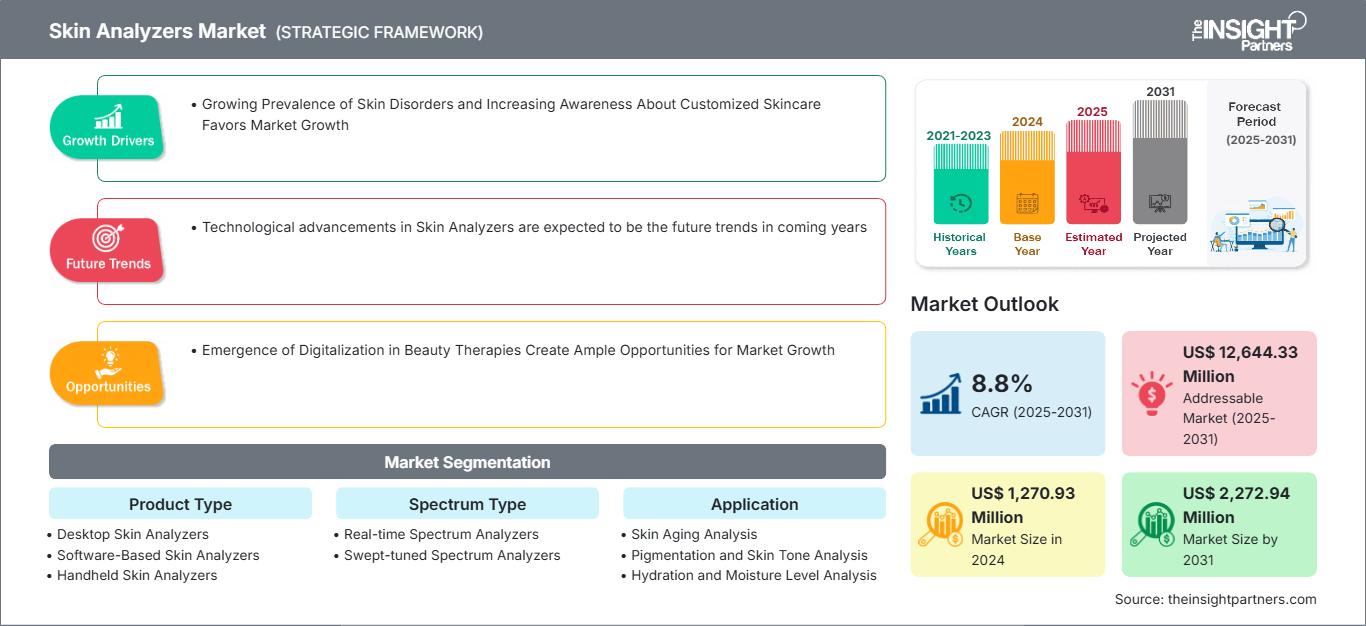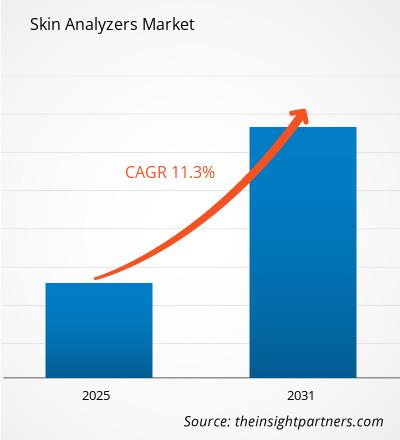预计到2031年,皮肤分析仪市场规模将从2024年的12.7093亿美元增至22.7294亿美元。预计2025年至2031年期间,该市场的复合年增长率将达到8.8%。皮肤分析仪技术的进步可能会在未来几年为市场带来新的趋势。
皮肤分析仪市场分析
推动皮肤分析仪市场发展的因素包括人们对皮肤病的认识和患病率的不断提高,以及护肤品个性化程度的不断提高。此外,市场参与者在皮肤分析仪领域不断推出的产品发布、合作和伙伴关系等战略举措预计将促进市场增长。美容疗法数字化的兴起预计将在未来几年创造大量机遇。
皮肤分析仪市场概览
预计北美将主导皮肤分析仪市场,而亚太地区预计将实现显著增长,这得益于消费者护肤意识的提升、个性化美容解决方案需求的不断增长,以及新兴经济体美容和健康产业的快速扩张。中国、日本、韩国和印度等国家正经历着增长,这得益于专业皮肤科诊所和家用护肤技术的兴起。此外,韩式美容和日式美容趋势的日益流行,以及人工智能和成像技术的进步,预计将推动皮肤护理专业人士和精通技术的消费者对皮肤分析仪设备的采用。此外,该地区不断增长的中产阶级人口及其不断增长的可支配收入也促进了对高级护肤诊断和治疗的支出增加。
自定义此报告以满足您的要求
您将免费获得任何报告的定制,包括本报告的部分内容,或国家级分析、Excel 数据包,以及为初创企业和大学提供超值优惠和折扣
皮肤分析仪市场: 战略洞察

- 获取本报告的主要市场趋势。这个免费样本将包括数据分析,从市场趋势到估计和预测。
您将免费获得任何报告的定制,包括本报告的部分内容,或国家级分析、Excel 数据包,以及为初创企业和大学提供超值优惠和折扣
皮肤分析仪市场: 战略洞察

- 获取本报告的主要市场趋势。这个免费样本将包括数据分析,从市场趋势到估计和预测。
皮肤分析仪的市场驱动因素和机遇
皮肤病患病率不断上升,人们对定制护肤的认识不断提高
全球皮肤病的发病率急剧上升。根据国际湿疹理事会的数据,2022 年全球约有 2.23 亿人患有特应性皮炎,其中 4300 万人年龄在 1-4 岁之间。根据美国国家牛皮癣基金会的数据,2022 年约有 1.25 亿人(约占全球人口的 2-3%)患有牛皮癣。此外,痤疮是全球大多数人最常见的疾病之一。根据美国皮肤病学会的数据,痤疮每年影响美国 5000 万人,全球患病率约为 20%。皮肤病发病率的上升导致了对诊断设备(例如皮肤分析仪)的需求增加,以监测和控制这些疾病。皮肤病负担正在上升,皮肤病在导致残疾的九大原因中排名第九,这凸显了对新型先进诊断技术的需求。皮肤病患病率的上升推动了皮肤分析仪市场的发展,因为医疗保健提供者和消费者都在寻求有效的早期诊断和控制措施。此外,美容平台分享护肤流程并教育消费者个性化护肤的重要性,也推动了人们对皮肤健康的日益重视。随着人们越来越意识到早期诊断和定制护肤的益处,消费者正在寻找先进的解决方案,例如皮肤分析仪,它可以提供有关其皮肤状况的精确信息,使他们能够对日常护肤做出明智的选择。因此,皮肤病患病率的不断上升以及人们对定制护肤意识的不断增强推动了皮肤分析仪市场的增长。
美容疗法数字化的兴起
美容治疗数字化的快速发展为创新和扩展提供了巨大的机会。将人工智能和机器学习等尖端技术融入皮肤分析,彻底改变了皮肤治疗。例如,欧莱雅和玉兰油已经开发出基于人工智能的皮肤分析仪,可以评估皮肤健康状况并根据具体需求提供定制的护肤方案。这些技术采用高分辨率成像和数据分析来提供准确的皮肤健康测量数据,使消费者能够对其护肤产品做出明智的决定。此外,美图秀秀等新兴应用程序使这些技术变得触手可及,消费者可以在智能手机上进行实时皮肤分析,将易用性与先进技术相结合。因此,预计美容护理领域的新兴数字化和技术进步将在预测期内为市场提供丰厚的机遇。
皮肤分析仪市场报告细分分析
促成皮肤分析仪市场分析的关键细分市场是产品类型、光谱类型、应用和最终用户。
- 根据产品类型,皮肤分析仪市场细分为台式皮肤分析仪、基于软件的皮肤分析仪和手持式皮肤分析仪。台式皮肤分析仪细分市场在 2024 年占据了最大的市场份额,而基于软件的皮肤分析仪细分市场预计将在 2025 年至 2031 年期间实现最高的复合年增长率。
- 按光谱类型,皮肤分析仪市场分为实时频谱分析仪和扫频调谐频谱分析仪。实时频谱分析仪细分市场在2024年占据了更大的市场份额,预计在2025年至2031年期间将实现更高的复合年增长率。
- 根据应用,皮肤分析仪市场细分为皮肤老化分析、色素沉着和肤色分析、水润度分析、皱纹和毛孔分析、紫外线损伤检测等。皮肤老化分析细分市场在2024年占据了最大的市场份额,预计在2025年至2031年期间将实现最高的复合年增长率。
- 就最终用户而言,皮肤分析仪市场细分为皮肤科诊所、美容诊所、家庭用户和研究机构。 2024 年,皮肤科诊所占据了市场主导地位,而美容诊所预计在 2025 年至 2031 年期间将实现最高的复合年增长率。
皮肤分析仪市场份额按地区分析
皮肤分析仪市场报告的地理范围主要分为五个地区:北美、亚太地区、欧洲、中东和非洲以及南美和中美。
2023 年,北美占据了相当大的市场份额。市场的增长得益于消费者对护肤的意识不断提高、对个性化美容解决方案的需求不断增加以及皮肤病诊断技术的进步。美国在北美拥有最大的市场份额,这得益于大量集成了先进皮肤分析工具的皮肤科诊所、美容中心和健康水疗中心。 VISIA 皮肤分析系统和 OBSERV 520X 等设备广泛应用于美容实践,用于评估皱纹、色素沉着和毛孔大小等皮肤状况。非侵入性治疗和预防性护肤的日益普及,推动了对精准诊断的需求。此外,疫情后远程皮肤病学服务的兴起,加速了便携式人工智能皮肤分析仪(例如 SkinVision)的普及。此外,美妆品牌与皮肤病学科技公司之间的合作,例如欧莱雅收购 ModiFace,预计将在未来几年推动市场增长。
皮肤分析仪市场区域洞察
The Insight Partners 的分析师已详尽阐述了预测期内影响皮肤分析仪市场的区域趋势和因素。本节还讨论了北美、欧洲、亚太地区、中东和非洲以及南美和中美洲的皮肤分析仪市场细分和地域分布。
皮肤分析仪市场报告范围
| 报告属性 | 细节 |
|---|---|
| 市场规模 2024 | US$ 1,270.93 Million |
| 市场规模 2031 | US$ 2,272.94 Million |
| 全球复合年增长率 (2025 - 2031) | 8.8% |
| 历史数据 | 2021-2023 |
| 预测期 | 2025-2031 |
| 涵盖的领域 |
By 产品类型
|
| 覆盖地区和国家 | 北美
|
| 市场领导者和主要公司简介 |
|
皮肤分析仪市场参与者密度:了解其对业务动态的影响
皮肤分析仪市场正在快速增长,这得益于终端用户需求的不断增长,而这些需求的驱动因素包括消费者偏好的不断变化、技术进步以及对产品优势的认知度不断提高。随着需求的增长,企业正在扩展产品线,不断创新以满足消费者需求,并抓住新兴趋势,从而进一步推动市场增长。

- 获取 皮肤分析仪市场 主要参与者概述
皮肤分析仪市场新闻及最新发展
- 皮肤分析仪市场评估是通过收集一手和二手研究后的定性和定量数据进行的,这些数据包括重要的企业出版物、协会数据和数据库。以下列出了皮肤分析仪市场的一些发展:
- 欧莱雅集团推出了L'Oréal Cell BioPrint,这是一款能够提供个性化皮肤分析的设备。这款桌面设备由欧莱雅集团与韩国初创公司NanoEnTek合作开发,利用生物标志物来洞察皮肤健康状况。它可以测量皮肤的生物年龄,预测皮肤对护肤成分的反应,并在潜在问题(例如黑斑或毛孔粗大)显现之前就发现它们。(来源:欧莱雅,新闻稿,2025年1月)
- MEICET推出了两款新型皮肤分析仪:PRO-A和3D D9。 PRO-A 和 3D D9 不仅拥有高精度的皮肤分析能力,更融入了智能化和人性化的设计,让用户能够更直观、更全面地了解自身的皮肤状况。(来源:MEICET,公司网站,2024 年 4 月)
- Flipkart 在其移动应用程序上推出了皮肤分析仪。它通过 AR 和 AI 等技术,根据个人肤质和关注点,提供个性化的护肤建议。(来源:Flipkart,新闻稿,2024 年 1 月)
皮肤分析仪市场报告覆盖范围和交付成果
《皮肤分析仪市场规模及预测(2021-2031)》报告提供了涵盖以下领域的市场详细分析:
- 皮肤分析仪市场规模以及涵盖范围内所有关键细分市场的全球、区域和国家/地区预测
- 皮肤分析仪市场趋势以及市场动态,例如驱动因素、限制因素和关键机遇
- 详细的 PEST 和 SWOT 分析
- 皮肤分析仪市场分析涵盖关键市场趋势、全球和区域框架、主要参与者、法规和最新市场发展
- 行业格局和竞争分析涵盖市场集中度、热图分析、知名参与者和皮肤分析仪市场的最新发展
- 详细的公司简介
- 历史分析(2 年)、基准年、预测(7 年)及复合年增长率
- PEST和SWOT分析
- 市场规模、价值/数量 - 全球、区域、国家
- 行业和竞争格局
- Excel 数据集
近期报告
客户评价
购买理由
- 明智的决策
- 了解市场动态
- 竞争分析
- 客户洞察
- 市场预测
- 风险规避
- 战略规划
- 投资论证
- 识别新兴市场
- 优化营销策略
- 提升运营效率
- 顺应监管趋势




















 获取免费样品 - 皮肤分析仪市场
获取免费样品 - 皮肤分析仪市场